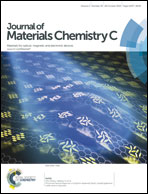Polymerisable octahedral rhenium cluster complexes as precursors for photo/electroluminescent polymers†
Abstract
New polymerisable photoluminescent octahedral rhenium cluster complexes trans-[{Re6Q8}(TBP)4(VB)2] (Q = S or Se; TBP – p-tert-butylpyridine; VB – vinyl benzoate) have been synthesised, characterised and used to construct rhenium cluster-organic polymer hybrid materials. These novel polymer systems are solution-processable and the rhenium clusters retain their photoluminescent properties within the polymer environment. Notably, when the rhenium cluster complexes are incorporated into the matrix of the electroluminescent polymer poly(N-vinylcarbazole), the resultant cluster polymer hybrid combined properties of both components and was used successfully in the construction of a polymer light emitting diode (PLED). These prototype devices are the first PLEDs to incorporate octahedral rhenium clusters and provide the first direct evidence of the electroluminescent properties of rhenium clusters and indeed, to the best of our knowledge, of any member of the family of 24-electron hexanuclear cluster complexes of molybdenum, tungsten or rhenium.


 Please wait while we load your content...
Please wait while we load your content...